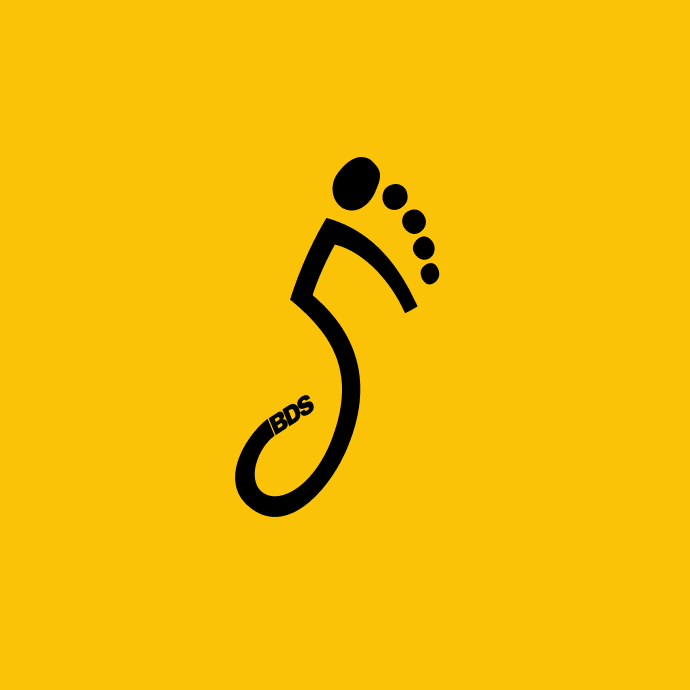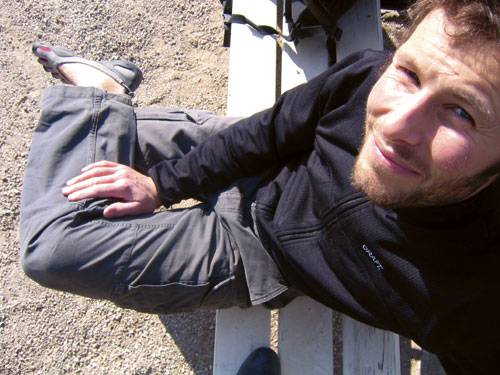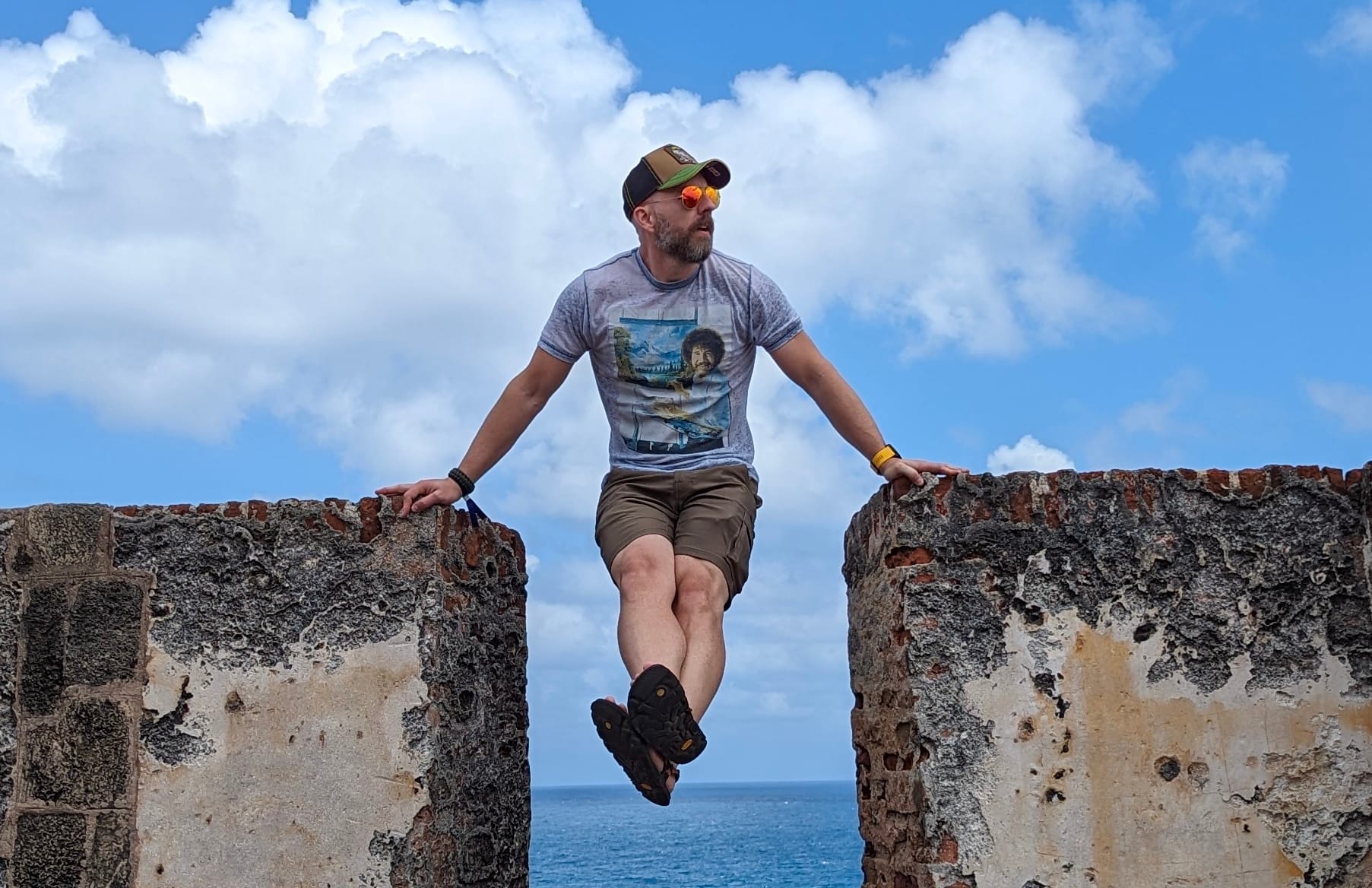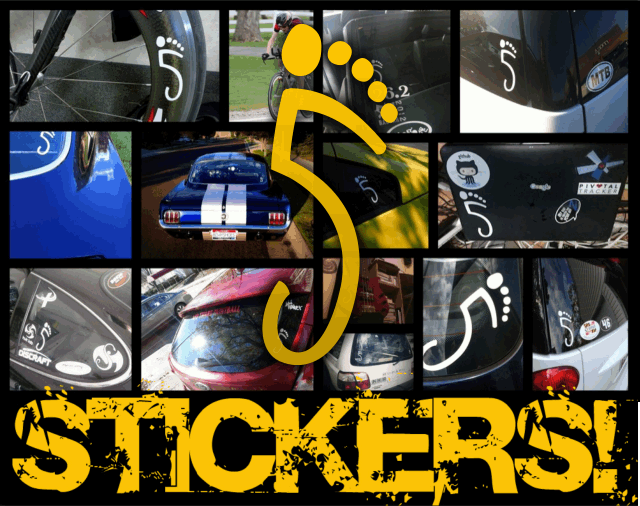Vibram FiveFingers — what are they?
The history of the world's first toe shoes is as weird as the shoes themselves. This is the definitive backstory of Vibram FiveFingers.

The origins of "toe shoes" — the original "barefoot shoe"
Vibram FiveFingers were the brainchild of Italian designer Robert Fliri.
Fliri first had the concept of a foot glove with articulated toes in 1999 — now known as FiveFingers and the original shoe that gave rise to the concept of the paradox of "barefoot shoes" (Learn more about "barefoot shoes" and other minimalist footwear here).
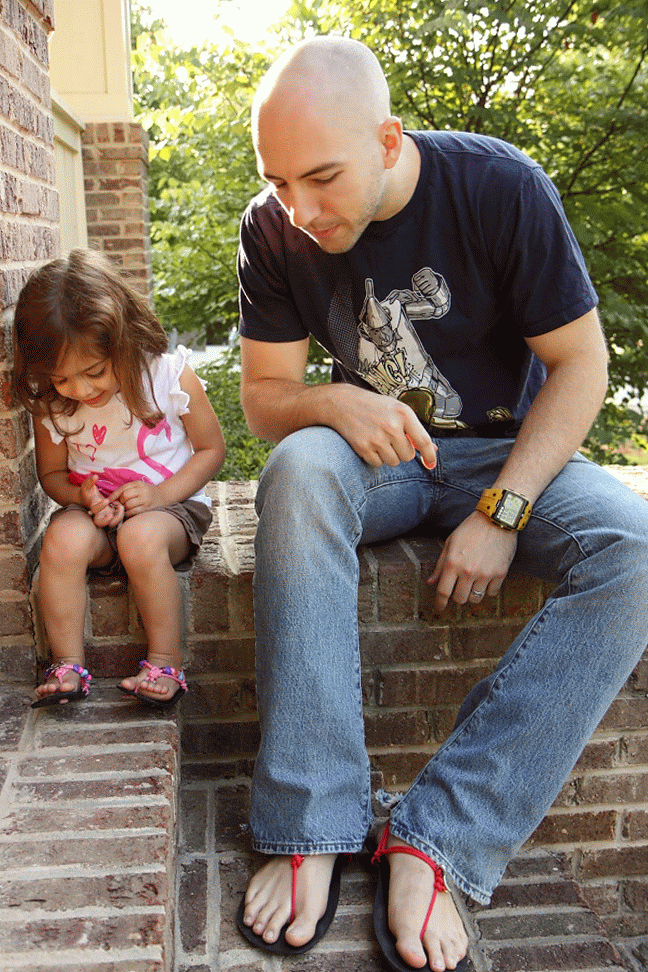
So the story goes, Fliri had been spending a good deal of time outdoors in the mountains of Italy, periodically taking off his shoes to go barefoot.
From these experiences Fliri conceptualized foot gloves ("toe shoes"), remarking that, "We have five toes: when they can move and grasp the ground independently, and when you can really sense the surface under your feet, your body is able to do what it is designed for by nature. That is a powerful feeling."
Fliri was making a simple case: if feet evolved by experiencing the world "naked," helping mankind survive along the way, why do we strap thick-soled and high-heeled shoes on in order to move about the world safely?
How could human beings have survived for generations with feeble, fragile feet?
The utility of toe shoes is more about what they aren't. Via negativa, thinly-soled, flexible, and lightweight toe shoes let feet do more of what they'd do if they were bare and exposed.
An idea waiting for the right time
Robert Fliri's toe shoe concept languished until a fortuitous meeting with Marco Bramani, the grandson of Vitale Bramani. Vitale Bramani is the founder of the Italian company Vibram (pronounced "Vee-brum"). As the legend goes, Bramani believed that Fliri's concept of a foot glove might make a novel choice of footwear for use on sailboats or in other activities that required greater ground-feel.
Sometime in the early 2000s, Bramani brought Fliri into his grandfather's company to develop the world's first toe shoes.
"Vibram FiveFingers" — so named because the Italian word for "fingers" is the same as that for "toes" — were born, a side project of a company that had only ever manufactured soles.
The time was coming for their widespread adoption — they just needed the right push.
Vibram FiveFingers start taking off
In 2006, Vibram FiveFingers were just starting to make waves as a novel, but incredibly strange, product. "Cool! But who would wear those? Not me!" It was around this time that "Barefoot" Ted McDonald contacted Vibram USA.
Barefoot Ted requested to try out the Classic Five Fingers for running.
Tony Post, the ex-Rockport Boston Marathon runner turned Vibram USA CEO (and much later, founder of Topo Athletic), spoke to McDonald. More likely, Ted spoke to Post (Ted is a talker), convincing Post he should run the Boston Marathon in Vibram FiveFingers.
The movement started to grow.
Vibram FiveFingers piqued the curiosity of anyone who saw them, slowly growing in popularity among fitness enthusiasts wanting a more "barefoot feel." Arnold Schwarzenegger famously lifted weights barefoot.
With the help of folks like Barefoot Ted, Barefoot Ken Bob Saxton, Mark Sisson (one of the Godfathers of the "paleo movement"), and others, FiveFingers grew and grew in awareness. A desire path toward was forming, one for more minimalist shoes, cut by pioneers in the barefoot and minimalist space.

Born to run with less shoe
Runners began taking serious note in 2009 thanks to Christopher McDougall's riveting Born to Run (Go here for a full review).
Born to Run takes a serious look at ultra long-distance runners and races; an indigenous long-distance running tribe, the Tarahumara Indians, living in the Copper Canyons of Mexico; and the high-incidence of running-related injuries — all cast against the past few decades of high-tech, ever-more engineered running shoes. McDougall weaves these stories together in an artful, can't-put-the-book down story with simple question at it's core: why are running shoes that are designed to prevent or reduce injuries not working?
Born to Run quickly became a bestseller.
Barefoot Ted is one of the main characters of Born to Run. In the book Ted is depicted running alongside the Tarahumara Indians in the Copper Canyons of Mexico in Vibram FiveFingers.
If "Barefoot Ted" (also known as "El Mono" or the "monkey" in the book) could run an ultramarathon wearing toe shoes, so very close to barefoot, in some of the harshest terrain on the planet, what was stopping any of us from doing the same?
Readers of Born to Run were left inspired to ditch their Nikes and try barefoot running — or pick up toe shoes like FiveFingers. The minimalist shoe and FiveFingers movements were in full motion.
Before long, Vibram FiveFingers were seen as a "barefoot running shoe."
Fliri's obscure foot glove and Bramani's boating shoe had gone mainstream.
Why are Vibram FiveFingers good for running, anyway?
"How could a shoe with no arch support and no cushioning be good for running? Wouldn't that hurt? You barefoot running people must be crazy!"
These are common statements and questions about FiveFingers-wearing runners — to say nothing of full barefoot runners.
Modern culture dictates you must wear running shoes, trainers, or sneakers to safely move around outside. It's assumed that asphalt is hard and dangerous to run on without lots of cushioning. It's even assumed that heel-striking is natural.
Like so many mainstream ideas, these preconceived notions about running are worth scrutinizing. For example, some research — like that of Dan Lieberman — has suggested that there is an inverse relationship between the amount of cushioning in your shoes and just how hard you're willing to strike the ground.
Is this so surprising? Appeal to your own intuition.
Imagine running barefoot across glass — you would land as gingerly and gently as you possibly could! The same goes for any hard surface.
Comparatively, add a bunch of foam underneath your foot. How would that change your movement? Now, landing forcefully on hard or sharp surfaces is covered over as the foam helps absorb the impact on your foot, muting the sensations of a varied, non-uniform ground.
Your running can be harder. Sloppier.
People running in cushioned shoes can now take longer strides, strike the ground hard, and strike the ground at their heel. The shockwave spawned by this striking then shoots up your ankle and leg. Further complicating the matter is that adding thick heels to your shoes changes your natural running gait from midfoot/forefoot to a heel-strike.
It's not that you can't run gently in modern running shoes, it's that you both don't have to and many find they simply can't (due to the forced heel-strike and the resulting shockwave).
Running barefoot or without much protection or cushioning (as with minimalist footwear) works so well at encouraging gentle, natural running because the lack of cushioning gives you more feedback. It triggers the anti-fragile nature of feet to adapt and grow stronger.
Lower impact and stronger feet are the result. (More on How to Run in FiveFingers here.) That's how the thinking goes, anyway, and science may ultimately bear this thinking out.
If barefoot is best, why wear Vibram FiveFingers?
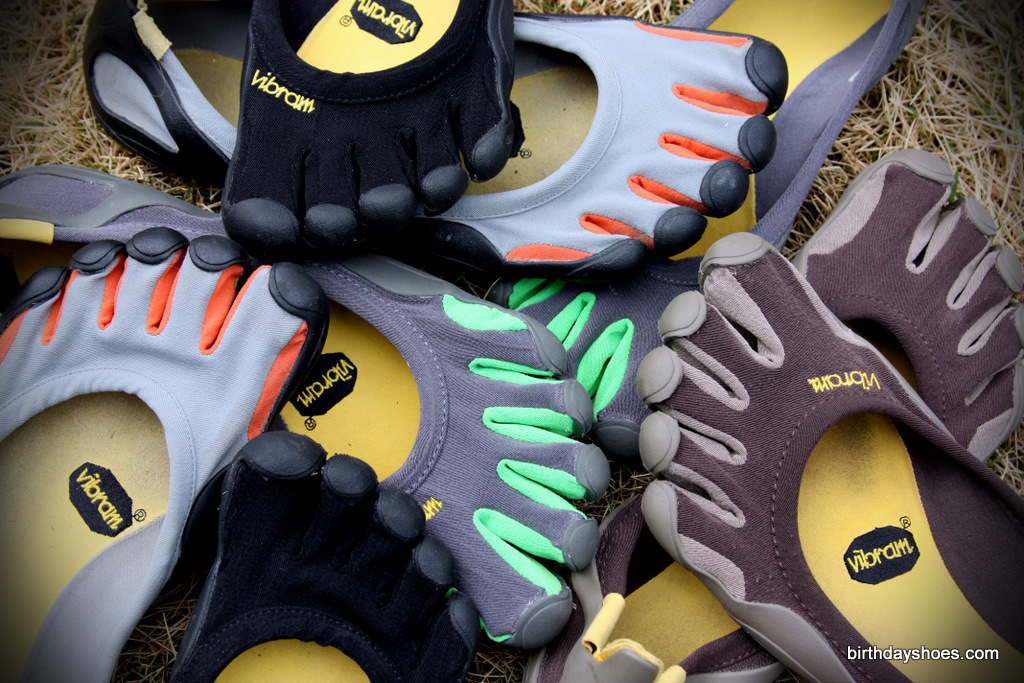
Vibram FiveFingers are less great because of what they are and more great because what they are not. They are just a thin bit of rubber strapped to your foot, complete with individual toe slots. They're just foot gloves — toe shoes or whatever you want to call them.
They offer no arch support to speak of and little cushioning. Their minimalist design puts your foot closer to a more natural, barefoot state. This works not because of the FiveFingers but because it suits the structure and function of the foot. As a result, FiveFingers allow your foot to express itself dynamically — meaning toes can move independently and the foot can flex, bend, and twist, engaging all the muscles and tendons of the foot similarly to how the foot would function barefoot. The thin layer of rubber in Five Fingers also allows a good deal (though not all) of ground feedback through to the foot while still affording some rubbery protection.
Vibram FiveFingers are not perfect — both muting ground feedback and being a "one-size-fits-most," mass-produced foot glove make them imperfect (barefoot and "shod" will never be equivalents!). FiveFingers specifically, and toe shoes generally, simply protect the foot a bit while getting out of the way of natural foot functionality.
If this is all FiveFingers can offer — less shoe — why not go all the way?
The answer to that depends on you. What are you ready to do with your feet? For most folks in this modern world, giving up any kind of foot gloves or shoes or sandals is "a bridge too far."
"Forget FiveFingers! I'm just going barefoot!" Sure, why not? You could be a purist here and take the highest ground. But there's also nothing wrong with wanting something on your feet. And there's some argument to be made that if you've adapted to wearing shoes for any kind of activity in the real world, you're going to have to rehabilitate your feet to the real world, anyway.
And maybe you should, but I'll save that discussion for another day.
The growth of "barefoot," minimalist footwear are growing!
Fast forward to today, and Vibram's FiveFingers shoes have revolutionized the sports shoe market by shifting the paradigm around what it means to have healthy shoes for running, playing, walking or whatever — our feet don't need lots of cushioning, arch support, elevated heels, or motion control to provide for safe movement.
As is the case with Vibram FiveFingers, a minimal sole (as little as 5–10mm thick) that is flexible and moves with your foot (thanks to the toe separation) can make for an incredibly versatile shoe — a shoe used for running marathons, walking, hiking, weight-lifting, travelling, casual wear, or really just about anything you can imagine.
A core tenet of BirthdayShoes (subscribe already) has been documenting just how users are using them.
And people are doing everything in FiveFingers and other minimalist shoes — often to the amazement of people stuck in the mindset that shoes need to be built up.
Since inception, FiveFingers has launched dozens of versions of their footwear, some of which have lasted for most of the duration of the product line. Others have come and gone. Many of them have been documented on this site.
(Some are really weird too.)
Onward!
Vibram Five Fingers have exploded the traditional footwear paradigm and are at the forefront of the minimalist footwear movement. As minimalist running has taken off, other shoe manufacturers have taken note and alternative "barefoot running shoes" or just close-to-barefoot casual shoes are starting to show up everywhere.
In short, a return to a more natural state of movement through "freeing your feet" is here to stay. As more and more people discover the "barefoot alternative" of Vibram Five Fingers, or simply the kid-like freedom of being barefoot outdoors, the traditional footwear that has dominated the sports shoe industry over the past few decades just may go away — or at least reduce in scope. Who needs over-engineered, over-hyped, over-marketed, over-cushioned foot casts on their feet anyway?
Wouldn't you rather let your feet be free?
Originally published in 2009. Updated in 2025.


